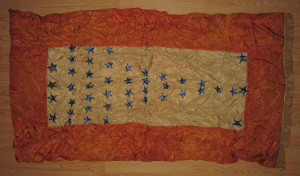An antique African American 45 star flag (one star is missing and there is evidence that one was there) measuring approximately 31 x 55 inches. Last origin was the Chicago estate of an African American collector who passed in 2011. I believe this flag passed through the gentleman’s family and has the makeup of “Sons in Service” flag with 45 stars representing local African American soldiers and totaling the number of stars on the American flag. It’s hanging orientation was probably vertical and there is an opening for the pole on the left side. Thanks for looking.
The 45-Star Flag became the Official United States Flag on July 4th, 1896. A star was added for the admission of Utah on January 4th, 1896, and was to last for 12 years. The Presidents to serve under this flag were Grover Cleveland (1893-1897), William McKinley (1897-1901),and Theodore Roosevelt (1901-1909). source:usflagsdotorg
One question often asked by new collectors is the meaning behind a flag-like banner that features a red border, white center, and blue stars. These banners became prevalent during World War I and World War II, and have also been hung during the Korean War, Vietnam War, The Gulf War and the current wars in Iraq and Afghanistan. They are an official US Military Appurtenance. Department of Defense Directive 1348.33, Manual of Military Awards and Decorations, specifies the regulations for the use and display of these Service Flags. They can be found in all sizes, from very small featuring only a single star, to large banners more than 10 feet in size, and featuring tens or even hundreds of stars. The banners were produced by families, local communities and businesses to represent sons who were fighting overseas. Each blue star represented one soldier, sailor or airman in the service. Although originally representing sons in earlier wars, today they represent both sons or daughters who are deployed for war. One of the most poignant traits of these flags is the presence of red or gold stars in place of (or on top of) the blue. The red represented a wounded service member and the gold represented a service member who was killed in action. The presence of these banners served as a constant reminder of why families, communities and businesses needed to remain dedicated to efforts to win the war and bring their sons and daughters back home. The gold stars reminded them of those who made the ultimate sacrifice and would never return home. source:rareflagsdotcom

